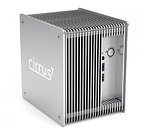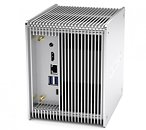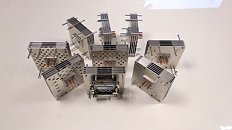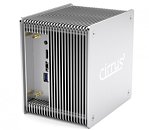Tuesday, November 13th 2018
cirrus7 Announces Nimbini 2.5 "Bean Canyon" Fanless NUC
Fanless mini-PC major cirrus7 rolled out the Nimnini 2.5, cube-shaped fanless NUC powered by Intel 8th generation "Coffee Lake" ("Kaby Lake-R") SoC, specifically the Core i7-8559U. This chip features a 4-core/8-thread CPU clocked at 2.70 GHz with 4.50 GHz boost, 8 MB L3 cache, and Intel Iris Plus 655 graphics processor that has 128 MB L4 cache. cirrus7's approach to cooling this 28W TDP MCM is an aluminium fin-stack heatsink that consists of large square aluminium plates that are held together by four 6 mm-thick copper heat pipes. The outer body continues along this design scheme. The company claims the case with its included heatsink runs the i7-8559U a whole 12 °C cooler than Intel's stock fan-heatsink based case.
The base-model of the cirrus7 Nimbini 2.5 includes a Core i3-8109U dual-core SoC, and is priced at 499€. You can configure it with a Core i5-8259U quad-core for an extra 139€, and the i7-8559U for 299€ over the base price. You add your own memory and storage. The NUC board supports up to two DDR4 SO-DIMM modules, holding up to 32 GB of memory. The Nimbini holds a 2.5-inch SATA drive in addition to the NUC board's M.2 slot. The case measures 157 mm x 157 mm x 120 mm (HxDxW), weighing 2.5 kg, including the heatsink and NUC motherboard option you choose.
Source:
FanlessTech
The base-model of the cirrus7 Nimbini 2.5 includes a Core i3-8109U dual-core SoC, and is priced at 499€. You can configure it with a Core i5-8259U quad-core for an extra 139€, and the i7-8559U for 299€ over the base price. You add your own memory and storage. The NUC board supports up to two DDR4 SO-DIMM modules, holding up to 32 GB of memory. The Nimbini holds a 2.5-inch SATA drive in addition to the NUC board's M.2 slot. The case measures 157 mm x 157 mm x 120 mm (HxDxW), weighing 2.5 kg, including the heatsink and NUC motherboard option you choose.




14 Comments on cirrus7 Announces Nimbini 2.5 "Bean Canyon" Fanless NUC
All cpu tower coolers have this genious design, but they cost at around 50 Eur for 800grams of ALU and engineering.
This one weighs 2.5kg for 500 eur
Furthermore, Arctic cooling Alpine 12 passive costs 9.80 eur and its 500grams of ALU.
This is rated for 37W TDP, and i can assure you, it does its job very well. I have a 58W TDP non U CPU running with this thing with no fans in an ITX case (26cm x 27cm x 9cm) full of cables.
heck, even intel own NUC with i5-8250 costs 400 eur and it's passive.
There is only one reason somebody would buy this - design. Everything else is terrible for the price tag.
As far as the price goes it is not all that bad.
Considerable part of the engineering challenge is probably the modularity of the heatsink. When looking at Cirrus7's page they offer the same case/heatsink in different widths and the third picture in the news post seems to illustrate some of that.
www.cirrus7.com/produkte/cirrus7-nimbini-v2/overview
Edit: I was wrong about the picture illustrating it. Their blog states these are heatsink variants they tested for the performance targets.
This heat sink WITHOUT any heatpipes at all is already overkill for things like i5-8250U and i5-8259U
Intel NUC BOXNUC8i5BEK2 costs 382 eur, that is 250eur cheaper.
-The cooler doesn't have heatpipes, but is seemingly held together with copper rods. Look at their ends - they're thick and flat, not tapered or pinched like a heatpipe. That might be a rushed render, of course, but then how do you fit five heatpipes across the core like that? Or is it two U-shaped and one L-shaped? If so: why?
-Not to sound overly snarky, but they came up with a common thermal transfer core that accepts various amounts of aluminium heatsink plates pressed onto it. Whoop de doo. This does not seem all that complicated. I get that there's a difference between napkin engineering and making an actual design and then bringing it to life with all the weirdness that manufacturing throws into the mix, but come on.
-The same goes for the case design: long screws, spacers, aluminium fins. Done. Add or remove holes, screws and spacers for increased rigidity. If the inner fins are the same ones that make up the outer sides, that's pretty clever, but also really, really simple. All that's needed is a half-decent metal workshop.
All in all, the pricing isn't terrible (they have R&D costs, after all, and I can't imagine stuff like this selling in massive quantities), but it's not good either. If the base motherboard is €250 and this is €500, that's at least €100 too much for the case alone.
If any disagree, go buy a pet rock.